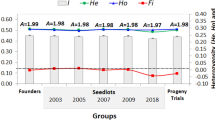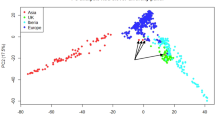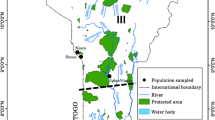Summary
Frequencies of three codominant alleles at the transferrin (Tf) locus and four of the six possible genotypes in a population of Nuttall's cottontails Sylvilagus nuttallii on an 87-ha study area in central Oregon were determined for parental stocks, trappable offspring, and over-winter survivors in 1974 and 1975. One rare allele disappeared during winter 1974–75 and did not reappear during the study. The Tf genotype frequency shifted in favor of Tf-BB between parents and offspring in 1974, remained stable over winter, shifted in favor of Tf-BC (to near the original frequency) between parents and offspring in 1975 and remained stable over winter. Allele and genotype frequencies were significantly different between 1974 and 1975 offspring; differences in frequencies between other samples were not significant because of the small number of cottontails that survived to spring each year. We were unable to discount the possibility of non-random breeding being responsible for observed differences, but, because survival of juveniles was related to moisture available for plant growth (and presumably to the moisture content in forage) during the cottontail breeding season and because frequencies of Tf genotypes of the four litters produced each year seemed related to available moisture, we postulated that precipitation was the selective force responsible for shifts in allele and genotype frequencies. Although we were unable to ascertain the probability that the polymorphism was balanced, the stochastic precipitation pattern seemed adequate to prevent fixation of an allele by selection if the selective mechanism was as postulated.
Similar content being viewed by others
References
Bailey NTJ (1952) Improvements in the interpretation of recapture data. J Anim Ecol 21:120–127
Berry RJ (1978) Genetic variation in wild house mice: where natural selection and history meet. Amer Sci 66:52–60
Calhoun JB (1950) Population cycles and gene frequency fluctuations in foxes of the genus Vulpes, in Canada. Can J Res, Ser D 28:45–57
Cochran WG (1963) Sampling techniques. John Wiley and Sons, Inc., New York
Edwards WR, Eberhardt L (1967) Estimating cottontail abundance from livetrapping data. J Wildl Manage 31:87–96
Gaines MS, Krebs CJ (1971) Genetic changes in fluctuating vole populations. Evolution 25:702–723
Gaines MS, Myers JH, Krebs CJ (1971) Experimental analysis of relative fitness in transferrin genotypes of Microtus ochrogaster. Evolution 25:443–453
Goodman M, Wolf RC (1963) Inheritance in serum transferrins in rhesus monkeys. Nature 197:1128
Gullion GW, Marshall WH (1968) Survival of ruffed grouse in a boreal forest. Living Bird 7:117–167
Marsden HM, Moller NR (1964) Social behavior in confined populations of the cottontail and the swamp rabbit. Wildl Monogr 13:1–39
Maurer FW (1967) Heritability of the plasma transferrin protein in three species of Microtus. Nature 215:95–96
McKay DO (1975) Dynamics of a population of mountain cottontail rabbits in central Oregon. MS Thesis, Oregon State Univ, Corvallis
McKay DO, Verts BJ (1978a) Estimates of some attributes of a population of Nuttall's cottontails. J Wildl Manage 42:159–168
McKay DO, Verts BJ (1978b) Habitat preference and dispersion of Nuttall's cottontails. Northwest Sci 52:363–368
Merrell DJ (1965) Distribution of the dominant burnsi gene in the leopard frog, Rana pipiens. Evolution 19:69–85
Merrell DJ, Rodell CF (1968) Seasonal selection in the leopard frog, Rana pipiens. Evolution 22:284–288
Petersen CGJ (1896) The yearly immigration of young plaice into the Limfford from the German Sea. Rept Danish Biol Sta for 1895, 6:1–77
Powers RA, Verts BJ (1971) Reproduction in the mountain cottontail rabbit in Oregon. J Wildl Manage 35:605–613
Rasmussen DI, Koehn RK (1966) Serum transferrin polymorphism in the deer mouse. Genetics 54:1353–1357
Richards GC (1979) Variation in water turnover by wild rabbits, Oryctolagus cuniculus, in an arid environment, due to season, age group and reproductive condition. Aust Wildl Res 6:289–296
Ridgeway CJ, Sherburne SW, Lewis RD (1970) Polymorphism in the esterases of Atlantic herring. Trans Amer Fish Soc 99:147–151
Tamarin RH, Krebs CJ (1969) Microtus population biology II. Genetic changes at the transferrin locus in fluctuating populations of two vole species. Evolution 23:183–211
Tamarin RH, Krebs CJ (1973) Selection at the transferrin locus in cropped vole populations. Heredity 30:53–62
US Department of Commerce (1949–1979) Climatological data, Oregon. Annual Summary 55–85
Walkowiak EF (1967) A serological and electrophoretic characterization of the serum proteins of Sylvilagus floridanus and Sylvilagus transitionalis. PhD Thesis, Univ Conn, Storrs
Author information
Authors and Affiliations
Rights and permissions
About this article
Cite this article
Skalski, J.R., Verts, B.J. Dynamics of a transferrin polymorphism in a population of Sylvilagus nuttallii . Oecologia 49, 329–332 (1981). https://doi.org/10.1007/BF00347593
Received:
Issue Date:
DOI: https://doi.org/10.1007/BF00347593




